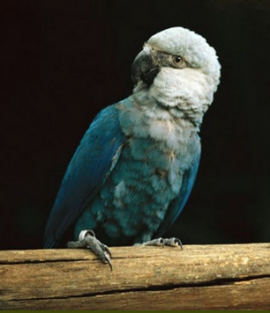Spix’s Macaw |
|
|
Also known as: Little Blue Macaw
Photos
View in GalleryDid You Know?
The the last known wild Spix's Macaw disappeared in 2000.Programs & Projects
WPT has worked with numerous partners to help save this species. Learn moreAcademic Research
Related publications: Cyanopsitta spixiiSpecies Profile
Genus: Cyanopsitta | Species: spixii
Size:
56cm (21.8 in)
Weight:
360g (12.6 oz)
Subspecies including nominate:
one
Colour Adult:
Both adults soft blue macaws with darker blue back and wings; grayish head. Eye ring grey, eye yellow. Bill black.
Colour Juvenile:
As in adults but with white eye ring. Eye dark brown. Bill with black and horn colouration.
Call:
Resonant, quieter and more wavering than Hyacinth Macaw. Also some screeching notes.
Listen NowVideo Links:
Video 1 | Video 2 | Video 3More Information:
Content Sources:
CITES
BirdLife International
Cornell Lab of Ornithology/Birds of the World
A Guide to Parrots of the World, Juniper and Parr, 1998
Vanished and Vanishing Parrots, Forshaw, 2017.
Parrots: Status Survey and Conservation Plan 2000-2004, Snyder, McGowan, Gilardi and Grajal, 2000.
Parrots of the World, Forshaw and Cooper, 1989.
Parrots of the World, Forshaw, 2006.
Parrots in Aviculture, Low, 1992.
Photos
View in GalleryDid You Know?
The the last known wild Spix's Macaw disappeared in 2000.Programs & Projects
WPT has worked with numerous partners to help save this species. Learn moreAcademic Research
Related publications: Cyanopsitta spixiiSpecies Care
Captive Status:
World population at about 130, all in captivity. Some held for conservation breeding purposes.
Longevity:
30-40 yrs.
Housing:
Walk-in enclosure, minimum length 7m (23 ft).
Diet:
Soaked or sprouted sunflower; walnuts, pecans, Brazil nuts, pine nuts; fresh corn, fruit and vegetables. If in tropical regions, palm fruits. Complete kibble for macaws.
Enrichment:
Are voracious chewers that need a variety of bird-safe, unsprayed branches and limbs. Require a lot of plantings in the aviary.
Nest Box Size:
80 x 30 x 30 cm box or stump.
Clutch Size:
2 to 3
Incubation Time:
26 days
Fledging Age:
8 weeks
Hatch Weight:
Probably 10-12g.
Peak Weight:
Not recorded.
Weaning Weight:
Not recorded.
Photos
View in GalleryDid You Know?
The the last known wild Spix's Macaw disappeared in 2000.Programs & Projects
WPT has worked with numerous partners to help save this species. Learn moreAcademic Research
Related publications: Cyanopsitta spixiiSpecies Wild Status
World Population:
Less than 150, all in captivity, plus occasional local reports from Serra da Capivara National Park, and a bird filmed near Curaçá in 2016.
IUCN Red List Status:
Extinct In The Wild
CITES Listing:
Appendix I
Threat Summary:
A BirdLife 'restricted-range' species. Affected by trapping for wild bird trade and almost total loss of caraiba woodland, its nesting habitat.
Range:
Formerly Rio Sao Franscisco Valley, northern Bahia, Brazil.
Habitat:
Required gallery woodland with Tabebuia caraiba trees along seasonal creeks in the caatinga for nesting.
Wild Diet:
Seeds of Cnidoscolus phyllacanthus and Jatropha pohlianna, seeds and fruit of Melanoxylon, fruit of Maytenus rigida and Ziziphus joazeiro and possibly nuts.
Ecology and Behaviour:
Formerly used well-used flight paths to and from food sources; until 1980s were strongly gregarious. Were seen to be strongly loyal to roosting and breeding trees.
Clutch and Egg Size:
2 to 3 eggs, 35.0 x 29.0mm (1.4 x 1.1 in).
Breeding Season:
November-March. Nest is in cavity (wild and captive birds).
Photos
View in GalleryDid You Know?
The the last known wild Spix's Macaw disappeared in 2000.Programs & Projects
WPT has worked with numerous partners to help save this species. Learn moreAcademic Research
Related publications: Cyanopsitta spixiiMembers Only Resources
Please log-in now to find more research, resources and tools.
Not a Member?
Find more great information:
Gain exclusive access to 600+ pages of additional research, seminars and podcasts, specialists to ask your toughest questions, and dozens of other fun resources - when you become a WPT member.
Join Today >>

































